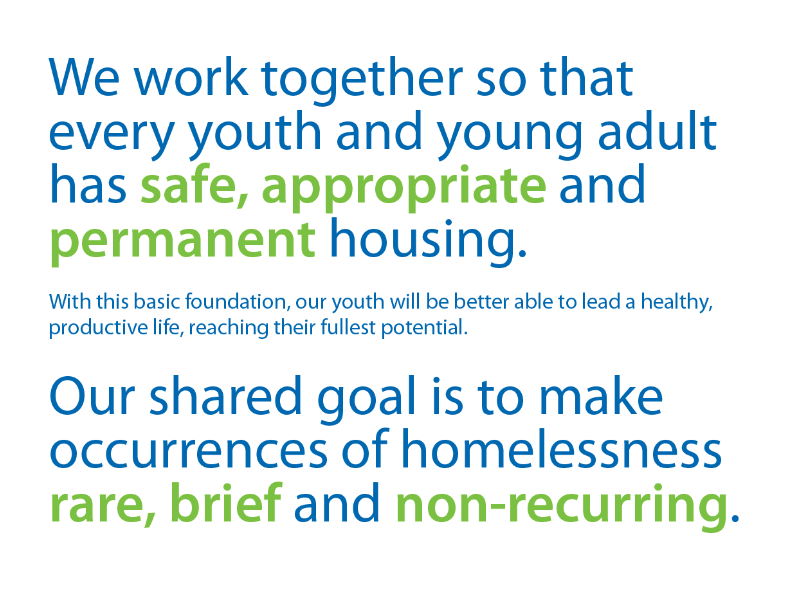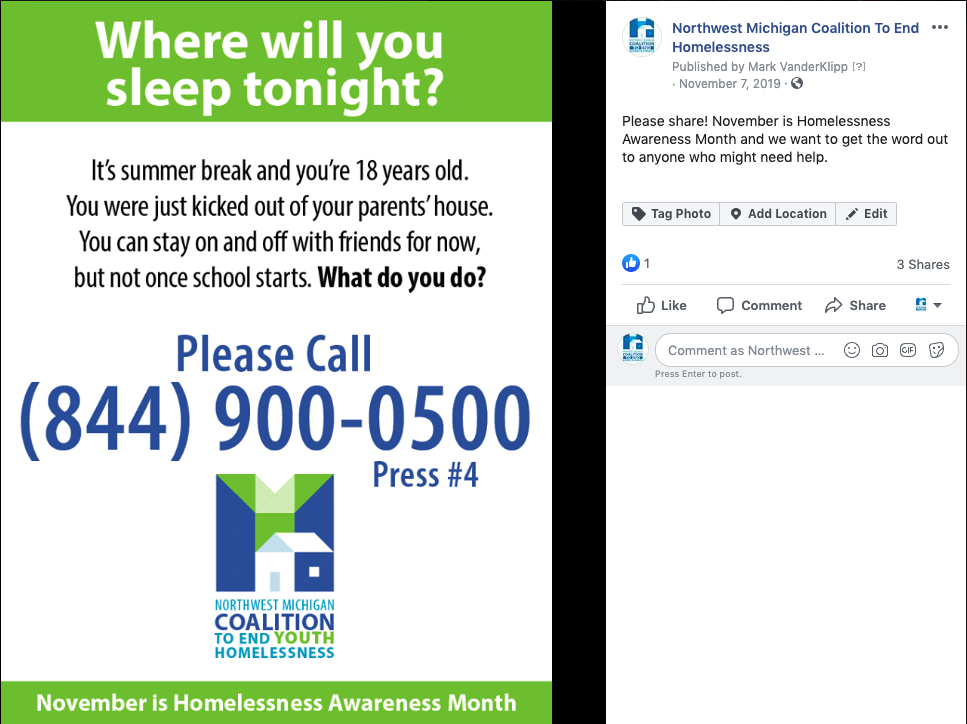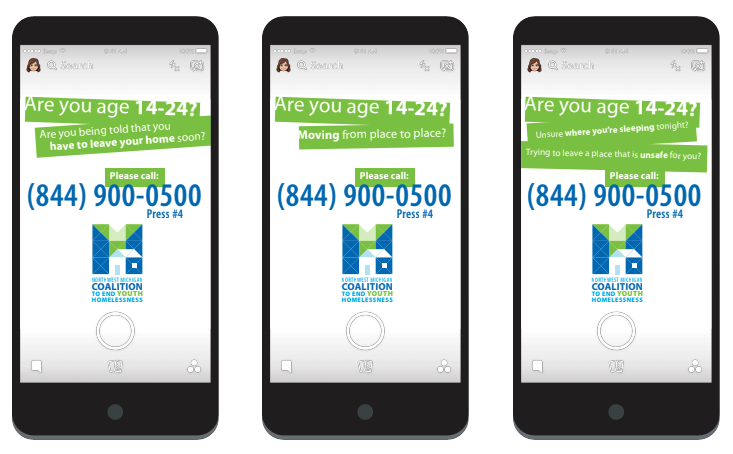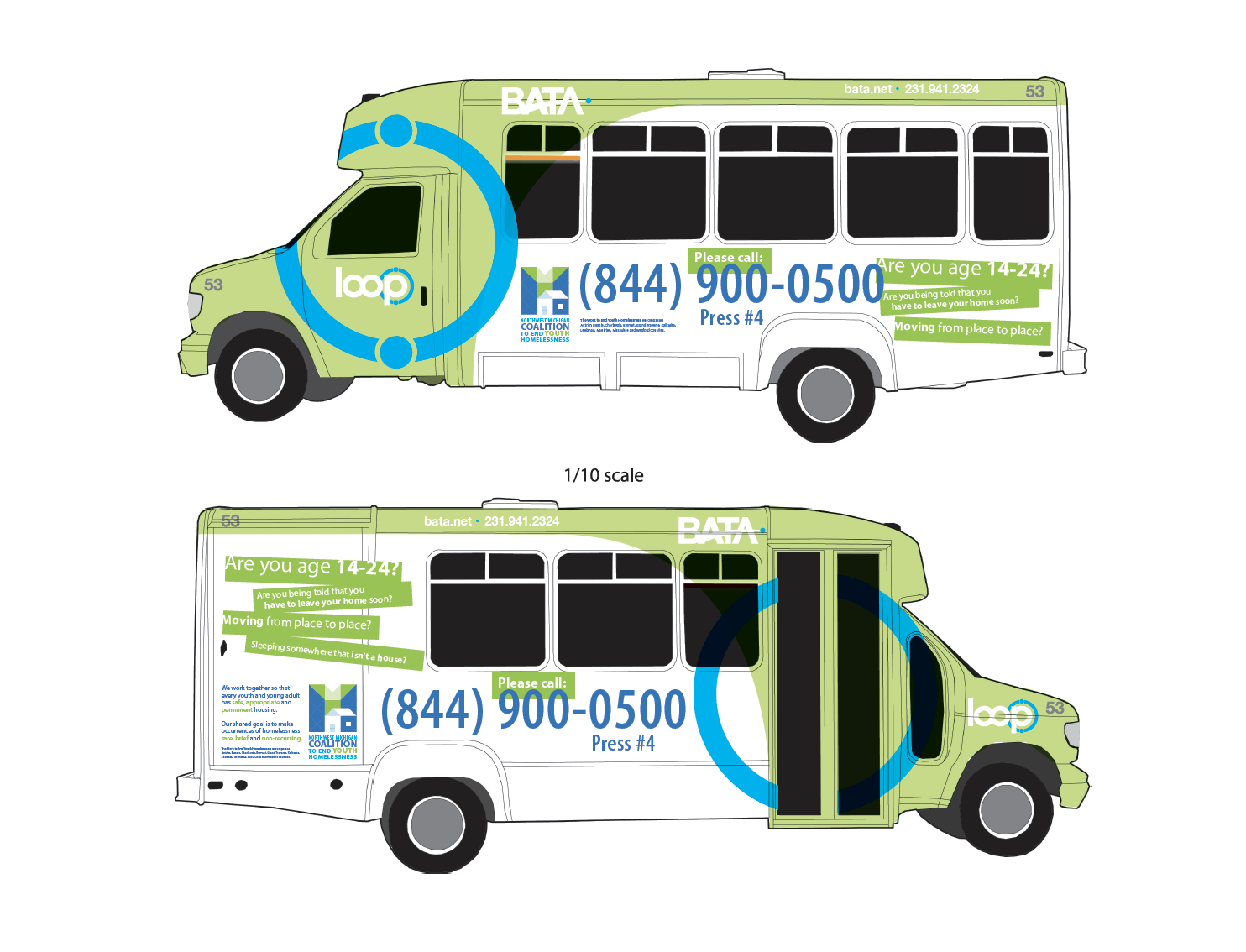Youth Homelessness
Strategic Plan
Stakeholders:
Member agencies and individuals of the Coalition to End Youth Homelessness; the Youth Action Board; formerly homeless youth
Human-Centered Design Services:
Facilitate, Communicate, Conceptualize, Prototype, Implement
In 2018 there were 191 homeless youth in the 10-county region of Northwest Lower Michigan. Of those, 38 were under age 18; 55 were survivors of domestic violence; 58 identify as disabled and 84 had experienced homelessness two or more times in the past three years.
For those who experience homelessness, our shared goal is to make these occurrences rare, brief and non-recurring.
Back in 2016, we helped the Northwest Michigan Coalition to End Homelessness apply for and receive a HUD grant that funded multiple innovations to reduce youth homelessness in Northern Michigan. But even as these innovations had been spread among multiple agencies, they were spoken of differently by different providers.
All told, we worked with leaders from over 12 different organizations including governmental, educational and non-profits with varying missions for youth. Because what good are services for homeless youth if no one knows what they are, when they can be used and how at-risk youth might qualify for them?
It’s heartening to see what you've woven together into a coherent set of clear and compelling images and messages. Your leadership skills have drawn out the the best intentions and visions of a broad and disparate group of stakeholders. No small feat!
Just really excited to see it all come together. I know there's a long way to go; just wanted to thank you for how far this effort has gone with your focused, calm, skillful leadership.
— Youth Action Board Community Advisor
Facilitate, Communicate: Develop Shared Language
The coalition asked us to convene, facilitate and think alongside individual agency leadership so that all would be “pulling in the same direction.” By doing this, scarce resources could be efficiently applied in the shared Work to End Youth Homelessness.
First, we needed to be on the same page with respect to the language each agency uses to communicate with their audiences. So we co-developed relevant statistics and a glossary of terms that lives on a shared Google Drive: all team members participated in developing this resource, and agreeing to the most impactful information.
Second, the group needed to develop the “elevator speech” that they, as independent members of the Coalition, would use - and agree to use it consistently. So we developed a Communication Charter that clearly defines the goals, purpose and guidelines for use of the tools we’d developed together.
We work together so that every youth and young adult has safe, appropriate and permanent housing. Given this basic foundation, they will be better able to lead a healthy, productive life, reaching their fullest potential. For those who experience homelessness, our shared goal is to make these occurrences rare, brief and non-recurring.
— Youth Coalition Charter
Conceptualize: Developing a Brand Family
Now it was time to incorporate the information into a shared identity and low-cost materials that could be produced on demand, saving time and printing costs.
When we began this project, we stressed the importance of having a “flagship” identity around which the group could rally, using it as an endorsement of any communication being presented by a given agency. Originally intended for the Homeless Youth effort only, we decided instead to redesign the entire Coalition system so that everyone would understand the various types of homelessness being impacted throughout our 10-county region.
The family of coalition logos that correspond to HUD funding categories/areas of focus. Each includes the letter H, its own color, integrated letterform and home with a unique window design.
Prototype, Implement
We then thought through how to spread the messages clearly, consistently and in a way that saves scarce funding resources. Together, we developed a family of pieces that can be printed in PDF format, color or black and white, to meet a given communications need. Working with the group’s already established communications media, we designed production-ready electronic files for:
The identity appears in a story intro for National Public Radio
A coalition brochure that can be printed one-sided on an 8.5” x 11” sheet and folded down to fit in a pocket or wallet;
Business cards that can be personalized based on the need;
Flyers for schools that encourage youth to share messages via social media to their friends and family members;
Formats for social media messages including Instagram, Facebook, etc.;
A flyer with tearoff information, placed strategically in public places such as bathrooms, libraries and other locations that allow for privacy;
A PowerPoint introduction for any presentation;
Animated GIF banners for Websites, e-newsletters or other formats; and
Bus wrap graphics to build awareness and provide anyone at risk of homelessness a phone number or email address to contact.
These are placed on the Coalition Website so that, once they agree to the Charter constraints, agencies can access them.
People Support What They Help Create
Working together, the coalition now has a series of tools – and guidelines for use of those tools – that they can use to consistently share messaging and statistics. These can be updated annually by design interns working for the Coalition, since all files exist in electronic form. With a consistent message to youth and the community, the Coalition can more effectively engage in The Work to End Youth Homelessness.













